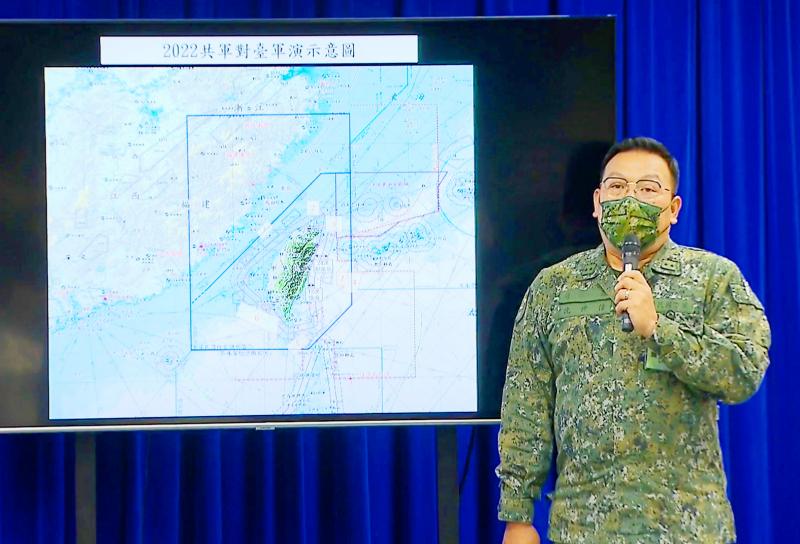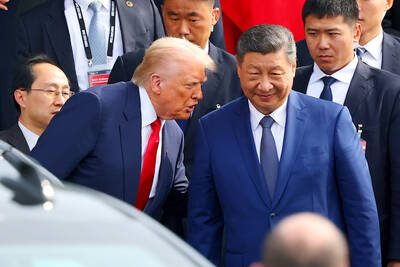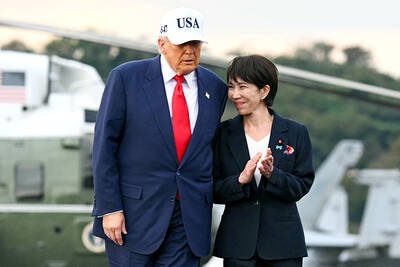The nation’s military fully complies with international rules and guidelines when responding to Chinese military drills, the Ministry of National Defense said yesterday, vowing to continue defending Taiwan in accordance with international law.
China on Thursday launched four days of military drills around Taiwan proper in response to US House of Representatives Speaker Nancy Pelosi’s visit to Taipei.
The drills were expected to end on Sunday, but neither Beijing nor Taipei confirmed their conclusion, although the Ministry of Transportation and Communications said it had seen some evidence suggesting at least a partial drawdown.

Photo courtesy of the Ministry of National Defense
However, China yesterday said the drills would continue, saying “the eastern theater of the Chinese People’s Liberation Army [PLA] continued to carry out practical joint exercises and training in the sea and airspace around Taiwan island.”
The exercises, the PLA’s Eastern Command said, were “focusing on organizing joint anti-submarine and sea assault operations.”
Beijing also carried out live-fire drills yesterday in parts of the South China Sea and Yellow Sea.
The Taiwanese defense ministry on Sunday said it detected 66 aircraft and 14 warships conducting naval and air exercises.
Taiwan has responded by putting its military on alert and deploying ships, planes and other assets to monitor Chinese aircraft, ships and drones that are “simulating attacks on the island of Taiwan and our ships at sea,” as well as crossing the median line of the Taiwan Strait.
Although not an internationally recognized delineation, the median line has been tacitly accepted by both sides since the 1950s, Shen Shih-wei (沈世偉), head of the ministry’s Judicial Department, told a news conference in Taipei yesterday.
Its existence is evident, but China’s creation of a restricted zone across the line challenges this nearly 70-year-old fact, he said.
The restricted zone constricts Taiwan’s training airspace, potentially affecting the normal operation of international air and waterways, Shen said.
This kind of targeted intimidation is contrary to Article 2, Section 4 of the UN Charter, which states: “All members shall refrain in their international relations from the threat or use of force against the territorial integrity or political independence of any state, or in any other manner inconsistent with the purposes of the United Nations,” Shen said.
Asked how the military monitors Chinese actions, Lieutenant General Yan Yu-hsien (顏有賢), Deputy Chief of the General Staff for Intelligence, said it uses joint intelligence, surveillance and reconnaissance methods.
For instance, when a Chinese aircraft or ship crosses the median line, the military — aside from broadcasting a warning — also communicates with warplanes and missile tracking systems to gain a thorough understanding of the situation, Yan said.
Warfare has changed dramatically in the Internet age, said Major General Chen Yu-lin (陳育琳), deputy director of the Political Warfare Bureau.
Disrupting the civilian Internet, cyberattacks would deepen the confrontation and potentially mean the difference between victory and defeat on the battlefield, she said.
China began cognitive warfare operations before the military drills, posting 272 messages from Monday last week to yesterday that were disseminated widely, ministry data showed.
The messages can be categorized into three types: creating a sense of unification by force, destroying trust in the government and disrupting morale, it said.
Navy Chief of Staff Vice Admiral Chiang Cheng-kuo (蔣正國) told reporters that China spread misinformation during the exercises.
It falsely claimed that its warships encroached on Taiwan’s territorial contiguous zone, but the navy confirmed that no PLA ships entered the nation’s territory, he said.
A country’s contiguous territorial zone extends for 24 nautical miles (44.4km) from its coast, while territorial waters extend 12 nautical miles. The military has not officially said whether PLA warships entered the nation’s contiguous zone.
Additional reporting by AP and AFP

UKRAINE, NVIDIA: The US leader said the subject of Russia’s war had come up ‘very strongly,’ while Jenson Huang was hoping that the conversation was good Chinese President Xi Jinping (習近平) and US President Donald Trump had differing takes following their meeting in Busan, South Korea, yesterday. Xi said that the two sides should complete follow-up work as soon as possible to deliver tangible results that would provide “peace of mind” to China, the US and the rest of the world, while Trump hailed the “great success” of the talks. The two discussed trade, including a deal to reduce tariffs slapped on China for its role in the fentanyl trade, as well as cooperation in ending the war in Ukraine, among other issues, but they did not mention

CALL FOR SUPPORT: President William Lai called on lawmakers across party lines to ensure the livelihood of Taiwanese and that national security is protected President William Lai (賴清德) yesterday called for bipartisan support for Taiwan’s investment in self-defense capabilities at the christening and launch of two coast guard vessels at CSBC Corp, Taiwan’s (台灣國際造船) shipyard in Kaohsiung. The Taipei (台北) is the fourth and final ship of the Chiayi-class offshore patrol vessels, and the Siraya (西拉雅) is the Coast Guard Administration’s (CGA) first-ever ocean patrol vessel, the government said. The Taipei is the fourth and final ship of the Chiayi-class offshore patrol vessels with a displacement of about 4,000 tonnes, Lai said. This ship class was ordered as a result of former president Tsai Ing-wen’s (蔡英文) 2018

Japanese Prime Minister Sanae Takaichi yesterday lavished US President Donald Trump with praise and vows of a “golden age” of ties on his visit to Tokyo, before inking a deal with Washington aimed at securing critical minerals. Takaichi — Japan’s first female prime minister — pulled out all the stops for Trump in her opening test on the international stage and even announced that she would nominate him for a Nobel Peace Prize, the White House said. Trump has become increasingly focused on the Nobel since his return to power in January and claims to have ended several conflicts around the world,

GLOBAL PROJECT: Underseas cables ‘are the nervous system of democratic connectivity,’ which is under stress, Member of the European Parliament Rihards Kols said The government yesterday launched an initiative to promote global cooperation on improved security of undersea cables, following reported disruptions of such cables near Taiwan and around the world. The Management Initiative on International Undersea Cables aims to “bring together stakeholders, align standards, promote best practices and turn shared concerns into beneficial cooperation,” Minister of Foreign Affairs Lin Chia-lung (林佳龍) said at a seminar in Taipei. The project would be known as “RISK,” an acronym for risk mitigation, information sharing, systemic reform and knowledge building, he said at the seminar, titled “Taiwan-Europe Subsea Cable Security Cooperation Forum.” Taiwan sits at a vital junction on